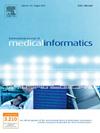Improving personalized healthcare with automated longitudinal EHR analysis
IF 4.1
2区 医学
Q2 COMPUTER SCIENCE, INFORMATION SYSTEMS
International Journal of Medical Informatics
Pub Date : 2025-06-23
DOI:10.1016/j.ijmedinf.2025.106010
引用次数: 0
Abstract
Background: Traditional Electronic Health Record (EHR) data analysis at King's College Hospital relies on extensive manual effort, from data extraction to reporting, limiting efficiency and scalability. This study presents an automated framework for longitudinal EHR data analysis to enhance personalized healthcare insights.
Methods: Central to the framework is the integration of Markov Chains with Survival Analysis (SA) and Latent Growth Modeling, enhancing the modeling of patient trajectories and capturing variances in growth patterns over time. Expectation-Maximization with Gaussian Mixture Models, extended with Latent Class Analysis, identifies clinically meaningful patient subgroups for tailored interventions. The framework addresses data uncertainty, enabling precise event forecasts and trajectory predictions. The system employs Apache NiFi for data ingestion, Elasticsearch for indexing, and Splunk and Kibana for real-time visualization and reporting. Natural Language Processing (NLP) techniques extract structured insights from unstructured clinical notes, enriching datasets with context. The automation significantly reduces manual processing while ensuring data integrity and enhancing predictive capabilities.
Main findings: Implementation demonstrated a 15% increase in detecting major depression cases, an 18% improvement in predicting patient decisions, a 25% reduction in growth trajectory prediction variance, and a 10% increase in event prediction accuracy. The framework enhances data-driven decision-making, supporting personalized healthcare interventions through real-time insights.
Conclusions: This automated framework integrates predictive modeling, NLP techniques, and real-time data processing, improving the efficiency and accuracy of longitudinal EHR analysis. Providing robust, actionable insights enables personalized healthcare delivery, enhances clinical decision-making, and optimizes patient outcomes.
通过自动纵向EHR分析改进个性化医疗保健
背景:国王学院医院的传统电子健康记录(EHR)数据分析依赖于大量的人工工作,从数据提取到报告,限制了效率和可扩展性。本研究提出了一个纵向电子病历数据分析的自动化框架,以增强个性化医疗保健见解。方法:该框架的核心是马尔可夫链与生存分析(SA)和潜在生长模型的整合,增强了患者轨迹的建模,并捕获了随时间变化的生长模式的差异。期望最大化与高斯混合模型,扩展与潜在类分析,确定临床有意义的患者亚组量身定制的干预。该框架解决了数据的不确定性,实现了精确的事件预测和轨迹预测。该系统使用Apache NiFi进行数据摄取,使用Elasticsearch进行索引,使用Splunk和Kibana进行实时可视化和报告。自然语言处理(NLP)技术从非结构化的临床记录中提取结构化的见解,通过上下文丰富数据集。自动化大大减少了人工处理,同时确保了数据完整性并增强了预测能力。主要发现:实施表明,发现重度抑郁症病例增加了15%,预测患者决策提高了18%,增长轨迹预测方差减少了25%,事件预测准确性提高了10%。该框架增强了数据驱动的决策,通过实时洞察支持个性化医疗保健干预。结论:该自动化框架集成了预测建模、NLP技术和实时数据处理,提高了纵向电子病历分析的效率和准确性。提供可靠的、可操作的见解可实现个性化医疗保健服务、增强临床决策并优化患者结果。
本文章由计算机程序翻译,如有差异,请以英文原文为准。
求助全文
约1分钟内获得全文
求助全文
来源期刊

International Journal of Medical Informatics
医学-计算机:信息系统
CiteScore
8.90
自引率
4.10%
发文量
217
审稿时长
42 days
期刊介绍:
International Journal of Medical Informatics provides an international medium for dissemination of original results and interpretative reviews concerning the field of medical informatics. The Journal emphasizes the evaluation of systems in healthcare settings.
The scope of journal covers:
Information systems, including national or international registration systems, hospital information systems, departmental and/or physician''s office systems, document handling systems, electronic medical record systems, standardization, systems integration etc.;
Computer-aided medical decision support systems using heuristic, algorithmic and/or statistical methods as exemplified in decision theory, protocol development, artificial intelligence, etc.
Educational computer based programs pertaining to medical informatics or medicine in general;
Organizational, economic, social, clinical impact, ethical and cost-benefit aspects of IT applications in health care.
 求助内容:
求助内容: 应助结果提醒方式:
应助结果提醒方式:


